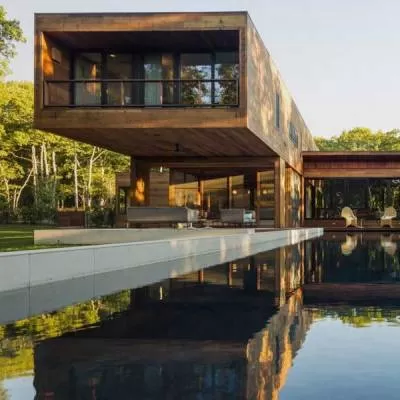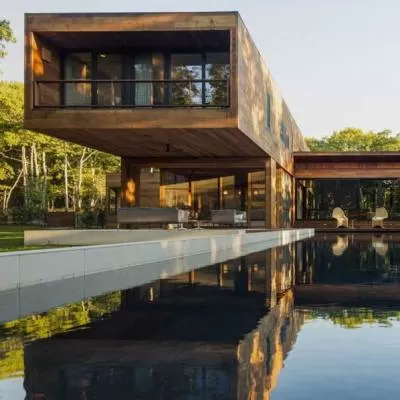- Home
- Real Estate
- We are averse to 'over-teching' our projects
We are averse to 'over-teching' our projects
Riding on the success and experience of Patel Engineering Ltd is Patel Realty India Ltd (PRIL), a company with a refreshing perspective on the real-estate scenario and projects in the country. Guided by the company's mantra, 'Engaging Earth', Managing Director Pravin Malkani is confident about the company's growth and future prospects. He shares his opinion on the market and upcoming projects with Shriyal Sethumadhavan; excerpts from the interview.....
PRIL opened its doors in Mumbai in 2007. In your opinion, how has the real-estate sector performed since then?
From 2007 to early 2009, the sector was overheated and performed exceptionally well. However, after the recession in 2009, it has completely changed in character; converting from a seller's market to a more buyer-centric market. While some geographies in India have partially adjusted to this change, some are still mulish. Hence, though the performance has been fair, it still needs to be studied for a year or more before being judged. Having said that, after recession, only two markets - India and China - have shown a positive outlook and growth. China seems to have performed better in terms of investments attracted. This has positioned India second, which in a sense makes it the second best real-estate market in the world today.
What led to the launch of PRIL?
Patel Realty was formed to monetise the land bank of its parent company, Patel Engineering Ltd. We have a land bank of over 1,100 acre located across various geographical regions of the country, including Maharashtra, Delhi, Bengaluru, Chennai and Hyderabad.
How does the company reflect its concept of 'holistic life' through its projects?
For the communities we develop, we like to offer a rounded and balanced lifestyle where people can experience a sense of belonging. Our built environments are developed around people and not FAR/FSI; our focus is the customer.
How do thought, sustainability, design and technology act as contributors to your projects?
Our thought process is provoked by creating relevant solutions for people belonging to various geographies. This thought process has a foundation wherein sustainability and design are deeply embedded. As far as technology goes, we aim to apply relevant technologies in our offerings. We are averse to 'over-teching' our projects just because they may be in vogue.
Please share the company's major milestones with us.
PRIL forayed into construction with a commercial project in Mumbai known as the Patel Corporate Park. We have also created an integrated township format called Neotown, which involves development of various typologies in the real-estate sector such as residential, commercial, retail, hospitality, etc. Currently, our real-estate pie has 55 per cent residential, 15 per cent commercial, 20 per cent retail and 10 per cent hospitality/other projects.
As reported, the Maharashtra Government plans to raise FSI for Mumbai from the existing 1.33 to 2.20. Having properties in Mumbai and Bengaluru - which has started giving FSI of 4 - how would this play a role in the execution of your projects?
A measure of supply and demand, FSI is an index and it must be flexible like all indices - stock, trading, oil, etc. Having said this, FSI per se is applicable to a non-perishable and immovable property, and therefore the complexities of such an index need to be studied, monitored and then applied. The applicable index must address the concerns of the population living in the city and its growth, and this projection must be done at realistic levels. The function of this index should primarily express the best and most efficient land usage, infrastructure available and demographics of the people using the same. Unfortunately, in India, it is treated as a multiplier more than an index. What is more unfortunate is that the interpretation is open-ended and not in consonance with building codes and norms, which themselves make little or no sense with respect to the index available.
Even if there are lands with a greater index, the buildings proposed have to still conform to the bylaws that would apply to a land with a lesser index. This is where the 'concessions' and interpretations come into play, along with various other devices that may be used to justify the concessions. However, we are not an FSI-focused company and believe in generating maximum revenue yield per sq ft and not just maximum sq ft.
For Townsville in Neotown, Bengaluru - a luxury residential project - you brought in European-style townhouses. How is this style suitable for the Indian market?
When we say European style, it is merely to orient the buyer to the typology of the product as it is a new offering in our markets. The disposition of Townsville created by PRIL is designed and built around a typical 'urban Indian' family. When we say it is styled European, it is merely the treatment given to the format; we don't mean it is European.
The new Land Acquisition and Rehabilitation and Resettlement Bill of 2011 states, 'The act will also apply when private companies acquire land more than 100 acre in rural areas and more than 50 acre in urban areas.' To what extent will such a condition affect a private developer and how affordable is it?
I personally view the act as regressive and a step back towards the License Raj. At a time when Indian developers have shown the calibre to develop large parcels of land successfully, here comes an act that constrains them in doing the very same. I do not understand the rationale behind this Act.
For your company, sustainability is not just a word but a commitment. Please elaborate.
Since inception, PRIL has been guided by a single mantra: 'Engaging Earth'. Our attempt is to be 'green neutral', that is, to enhance the environment and refrain from degrading it further. We constantly work towards improving our strategies to be more green positive and environment relevant.
The Ministry of New and Renewable Energy entrusted TERI's independent body, ADaRSH, to promote and implement the GRIHA rating system for large developments like townships and SEZ. How do you believe this will address the lack of adequate guidelines for sustainable design, planning and development for large developments?
Implementing the GRIHA rating system is a step in the right direction; like any new initiative, its guidelines will go through a learning curve until they settle down as 'applicable'. I hope the ministry continues to engage in dialogue with the developers of townships and SEZs to continue adjusting and tweaking the guidelines to ensure their applicability. If not, we may just have another good initiative that will merely be used to green pockets, and not the environment.
Considering your international footprint, do you think Indian guidelines and clearances are on a par with international standards?
Our international experience has surprisingly revealed that a large number of the guidelines as 'written down' in India are sometimes much better than those practiced in some other countries. The issue in India is not the written guidelines; it is really the spirit of implementation that cripples the law or guideline. Having said that, some of our guidelines are draconian and obsolete and act as roadblocks to development.
How do you view the Indian real-estate industry's growth in the coming year? How will this affect PRIL's growth graph?
The real-estate sector has been and will stay bullish for the coming year. I expect to see growth that may be a bit slower than its potential owing to several factors like interest rates and the global financial situation. However, at PRIL, we are fortunate to continue to programme our real-estate initiatives on the historical land banks of Patel Engineering Ltd. This allows us to adjust our go-to-market pricing, and, therefore, we believe the company will actually accelerate its growth over the next year.
With operations in Mumbai, Bengaluru, Noida and Mauritius, do you have any expansion plans in the near future?
Having commenced initial works in Hyderabad and Chennai, in the near future we look forward to announcing some projects in at least one of the above locations. We will be more aggressive in our township in Bengaluru where we intend to announce more projects in Neotown-Bengaluru South. In the immediate future, we are looking to consolidate and focus on execution and delivery. In the midterm, we plan to announce more projects on existing land banks and, in the long run, PRIL will continue to acquire land banks as we have realised the value of historical land.
Fact sheet:
- Year of Establishment: 2007
- Top Management (Promoters): Pravin Malkani-Managing Director; Sanjay Javkar-Vice President, Finance
- No. of Employees: Over 100
- Centre(s) of Operation: Mumbai (Head Office)
- Ongoing Projects: Neotown, Bengaluru (integrated township); Neotown, Port Louis (integrated township); Estate, Mumbai (commercial)
- Upcoming Projects: Hyderabad and Chennai
- Turnover: (FY10-11) Rs 119 crore
Pravin Malkani, Managing Director, Patel Realty India LtdRiding on the success and experience of Patel Engineering Ltd is Patel Realty India Ltd (PRIL), a company with a refreshing perspective on the real-estate scenario and projects in the country. Guided by the company's mantra, 'Engaging Earth', Managing Director Pravin Malkani is confident about the company's growth and future prospects. He shares his opinion on the market and upcoming projects with Shriyal Sethumadhavan; excerpts from the interview.....PRIL opened its doors in Mumbai in 2007. In your opinion, how has the real-estate sector performed since then?From 2007 to early 2009, the sector was overheated and performed exceptionally well. However, after the recession in 2009, it has completely changed in character; converting from a seller's market to a more buyer-centric market. While some geographies in India have partially adjusted to this change, some are still mulish. Hence, though the performance has been fair, it still needs to be studied for a year or more before being judged. Having said that, after recession, only two markets - India and China - have shown a positive outlook and growth. China seems to have performed better in terms of investments attracted. This has positioned India second, which in a sense makes it the second best real-estate market in the world today.What led to the launch of PRIL?Patel Realty was formed to monetise the land bank of its parent company, Patel Engineering Ltd. We have a land bank of over 1,100 acre located across various geographical regions of the country, including Maharashtra, Delhi, Bengaluru, Chennai and Hyderabad.How does the company reflect its concept of 'holistic life' through its projects?For the communities we develop, we like to offer a rounded and balanced lifestyle where people can experience a sense of belonging. Our built environments are developed around people and not FAR/FSI; our focus is the customer.How do thought, sustainability, design and technology act as contributors to your projects?Our thought process is provoked by creating relevant solutions for people belonging to various geographies. This thought process has a foundation wherein sustainability and design are deeply embedded. As far as technology goes, we aim to apply relevant technologies in our offerings. We are averse to 'over-teching' our projects just because they may be in vogue.Please share the company's major milestones with us.PRIL forayed into construction with a commercial project in Mumbai known as the Patel Corporate Park. We have also created an integrated township format called Neotown, which involves development of various typologies in the real-estate sector such as residential, commercial, retail, hospitality, etc. Currently, our real-estate pie has 55 per cent residential, 15 per cent commercial, 20 per cent retail and 10 per cent hospitality/other projects.As reported, the Maharashtra Government plans to raise FSI for Mumbai from the existing 1.33 to 2.20. Having properties in Mumbai and Bengaluru - which has started giving FSI of 4 - how would this play a role in the execution of your projects?A measure of supply and demand, FSI is an index and it must be flexible like all indices - stock, trading, oil, etc. Having said this, FSI per se is applicable to a non-perishable and immovable property, and therefore the complexities of such an index need to be studied, monitored and then applied. The applicable index must address the concerns of the population living in the city and its growth, and this projection must be done at realistic levels. The function of this index should primarily express the best and most efficient land usage, infrastructure available and demographics of the people using the same. Unfortunately, in India, it is treated as a multiplier more than an index. What is more unfortunate is that the interpretation is open-ended and not in consonance with building codes and norms, which themselves make little or no sense with respect to the index available.Even if there are lands with a greater index, the buildings proposed have to still conform to the bylaws that would apply to a land with a lesser index. This is where the 'concessions' and interpretations come into play, along with various other devices that may be used to justify the concessions. However, we are not an FSI-focused company and believe in generating maximum revenue yield per sq ft and not just maximum sq ft.For Townsville in Neotown, Bengaluru - a luxury residential project - you brought in European-style townhouses. How is this style suitable for the Indian market?When we say European style, it is merely to orient the buyer to the typology of the product as it is a new offering in our markets. The disposition of Townsville created by PRIL is designed and built around a typical 'urban Indian' family. When we say it is styled European, it is merely the treatment given to the format; we don't mean it is European.The new Land Acquisition and Rehabilitation and Resettlement Bill of 2011 states, 'The act will also apply when private companies acquire land more than 100 acre in rural areas and more than 50 acre in urban areas.' To what extent will such a condition affect a private developer and how affordable is it?I personally view the act as regressive and a step back towards the License Raj. At a time when Indian developers have shown the calibre to develop large parcels of land successfully, here comes an act that constrains them in doing the very same. I do not understand the rationale behind this Act.For your company, sustainability is not just a word but a commitment. Please elaborate.Since inception, PRIL has been guided by a single mantra: 'Engaging Earth'. Our attempt is to be 'green neutral', that is, to enhance the environment and refrain from degrading it further. We constantly work towards improving our strategies to be more green positive and environment relevant.The Ministry of New and Renewable Energy entrusted TERI's independent body, ADaRSH, to promote and implement the GRIHA rating system for large developments like townships and SEZ. How do you believe this will address the lack of adequate guidelines for sustainable design, planning and development for large developments?Implementing the GRIHA rating system is a step in the right direction; like any new initiative, its guidelines will go through a learning curve until they settle down as 'applicable'. I hope the ministry continues to engage in dialogue with the developers of townships and SEZs to continue adjusting and tweaking the guidelines to ensure their applicability. If not, we may just have another good initiative that will merely be used to green pockets, and not the environment.Considering your international footprint, do you think Indian guidelines and clearances are on a par with international standards?Our international experience has surprisingly revealed that a large number of the guidelines as 'written down' in India are sometimes much better than those practiced in some other countries. The issue in India is not the written guidelines; it is really the spirit of implementation that cripples the law or guideline. Having said that, some of our guidelines are draconian and obsolete and act as roadblocks to development.How do you view the Indian real-estate industry's growth in the coming year? How will this affect PRIL's growth graph?The real-estate sector has been and will stay bullish for the coming year. I expect to see growth that may be a bit slower than its potential owing to several factors like interest rates and the global financial situation. However, at PRIL, we are fortunate to continue to programme our real-estate initiatives on the historical land banks of Patel Engineering Ltd. This allows us to adjust our go-to-market pricing, and, therefore, we believe the company will actually accelerate its growth over the next year.With operations in Mumbai, Bengaluru, Noida and Mauritius, do you have any expansion plans in the near future?Having commenced initial works in Hyderabad and Chennai, in the near future we look forward to announcing some projects in at least one of the above locations. We will be more aggressive in our township in Bengaluru where we intend to announce more projects in Neotown-Bengaluru South. In the immediate future, we are looking to consolidate and focus on execution and delivery. In the midterm, we plan to announce more projects on existing land banks and, in the long run, PRIL will continue to acquire land banks as we have realised the value of historical land.Fact sheet:Year of Establishment: 2007 Top Management (Promoters): Pravin Malkani-Managing Director; Sanjay Javkar-Vice President, FinanceNo. of Employees: Over 100 Centre(s) of Operation: Mumbai (Head Office) Ongoing Projects: Neotown, Bengaluru (integrated township); Neotown, Port Louis (integrated township); Estate, Mumbai (commercial) Upcoming Projects: Hyderabad and Chennai Turnover: (FY10-11) Rs 119 croreTo give your feedback on this interview, write in at feedback@ASAPPmedia.com



















